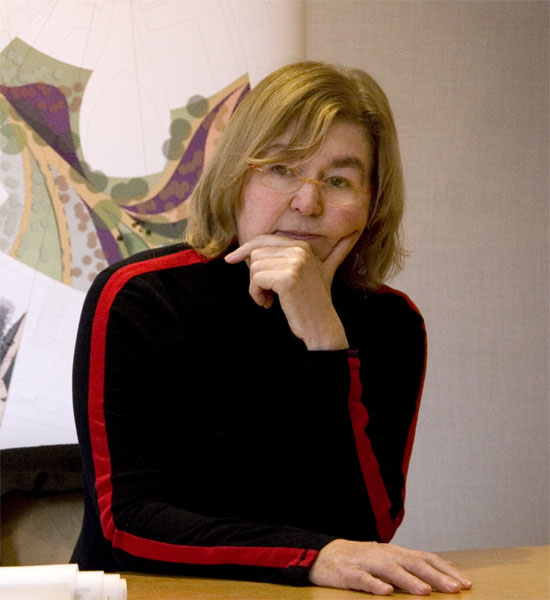Architect Balmori eyes sustainable Chinese cities
- By Wu Jin
 0 Comment(s)
0 Comment(s) Print
Print E-mail
China.org.cn, December 5, 2011
E-mail
China.org.cn, December 5, 2011
From the swaying reeds on top of the 684 Broadway Penthouse in Manhattan to the colorful grassland zigzagging the stone stairs in Bilbao Jardin, Spain; from New York's flower-dotted Skid Row to the magical Botanical Research Institute of Texas, New York architect Diana Balmori displays her genius for fusing nature into urban life, with a philosophy she calls "sustainability".
|
|
|
Diana Balmori [by Margaret Morton] |
Born into a scholarly family in Spain, Balmori was drawn to art at an early age. An imaginative and creative child, she was encouraged to explore a wide range of subjects, including literature, Latin, Greek, painting and music. Having traveled between Spain and England, her family finally settled in Argentina, where Balmori received her undergraduate education. She then immigrated to the United States and continued her education at the University of California at Los Angeles, where she earned her Ph.D in Urban History. Upon her graduation, she accepted a teaching position at the State University of New York and held undergraduate seminars in Landscape History at the Yale School of Architecture. In 1990, she started her own firm, Balmori Associates.
Now, with the Chinese translation of her latest publication "A Landscape Manifesto", the landscape designer is turning her attention to China. Her book is considered a collection of ecological and aesthetic theories adopted for urban construction and a philosophical exploration in nature and human relations, according to Yale University Press.
"I think the book is particularly apt for China in the sense that it is a rapidly developing economy, and it would benefit enormously from having sustainable development, which means a development that works as close as possible to the way that nature's mechanisms work," said Balmori, in an email interview with China.org.cn.
The idea of "sustainable development" isn’t unfamiliar to the majority of Chinese people, who see the phrase liberally scattered throughout government documents and speeches. However, many people are unsure about how to put the idea into practice.
Enter Balmori's book, which offers an array of hints and tips as to how people can make their city a better place to live. "Be it large or small, more pleasant and healthy, there are simple things that can be done to make life in a city more pleasant," said Balmori.
Having visited China several times, Balmori said she was amazed at the pace of change in the country. She was particularly impressed by the scale of tree-planting in China, and also commented on a number of landscape and architecture projects which focused on sustainability.
However, Balmori fears that, with the astonishing speed of China's transformation, the country is neglecting the protection and preservation of its historic sites and buildings. "To have buildings all of one era in one place, and particularly high-rise buildings, only makes for a boring city and one not attuned to life on the street," said Balmori. "There should be a better mix of old and new."
Although Balmori is a contemporary architect in one of the world’s largest and most modern metropolises, she displays a great affection for traditional architecture and gardens. China's Suzhou Garden is a particular favorite, and she is also fascinated by the sophistication of the quadrangles and courtyards, calling them "a brilliant invention". "The Southern Chinese gardens give you the feeling of very large spaces within a really tight urban space," she commented. "The layers of walls in those gardens, the semi-transparency from one space to another is surprising and effective in giving a sense of space. I have learned a lot from them."
Gaining knowledge from the past also inspires in shaping the future. Following the principles of the Chinese courtyards, where houses were built among trees, ponds and grass, Balmori is determined to stay true to her ideal of integrating architecture and landscape. "The landscape will have a much more prominent role in cities (in future), and not just as parks or private gardens, but rather by making green roofs, green walls, linear parks that snake through the city, integrating river shores and mountains into the cities," said Balmori. "Also in the future, buildings will function much more as living beings-- breathing, opening and closing their exterior shell."







Go to Forum >>0 Comment(s)